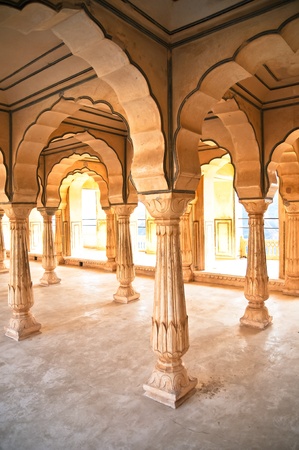Introduction: Rediscovering Indianness through Heritage
India’s architectural legacy is a tapestry woven with stories of grandeur, craftsmanship, and cultural pride. Today, as urban India experiences rapid growth and modernisation, there is a renewed fascination for the timeless elegance found in ancient Indian palaces. These majestic structures—be it the intricate jharokhas of Rajasthan or the ornate courtyards of Mughal architecture—stand as living testaments to the country’s rich traditions and indigenous design philosophies. By drawing inspiration from these regal palaces, contemporary Indian homes are beginning to reflect a unique blend of tradition and modernity. This resurgence goes beyond aesthetics; it represents a deeper quest to rediscover Indianness, celebrating our heritage while adapting it for present-day lifestyles. In this context, exploring the relevance of ancient Indian palaces helps us set the tone for embracing traditional elements in today’s home designs, ensuring that cultural identity and craftsmanship remain at the heart of every modern Indian living space.
Architecture and Layout: Spatial Grandeur Meets Today’s Needs
When we look at the architectural marvels of ancient Indian palaces, it’s impossible to ignore their sense of scale, symmetry, and thoughtful spatial planning. These grand structures were not just about luxury—they were meticulously designed to accommodate climatic conditions, social hierarchies, and a rich cultural life. Today, as modern Indian homeowners seek to incorporate heritage with convenience, the elements of courtyards (aangan), jharokhas (overhanging enclosed balconies), and chhatris (elevated dome-shaped pavilions) offer timeless inspiration for contemporary layouts.
The Courtyard: Breathing Life into Urban Homes
In traditional palaces, the courtyard was the heart of the home—a place for gatherings, rituals, and natural ventilation. Modern interpretations bring this concept into urban residences, creating central open-to-sky spaces that foster community interaction while improving airflow and daylight.
| Palace Feature | Traditional Purpose | Modern Adaptation |
|---|---|---|
| Courtyard (Aangan) | Social hub, climate control | Central lounge or garden area for family activities and natural light |
| Jharokha | Privacy, aesthetics, cross-ventilation | Bay windows or enclosed balconies blending privacy with outdoor views |
| Chhatri | Ceremonial pavilion, architectural focal point | Rooftop gazebos or terrace pavilions for relaxation and gatherings |
Jharokhas: Merging Privacy with Panache
The jharokha is more than an ornamental balcony—it represents a unique way to enjoy views while maintaining seclusion. In todays apartments and villas across India, designers are reimagining jharokhas as reading nooks or private lounges that celebrate both tradition and personal space.
Chhatris: Adding Character to Contemporary Roofscapes
Chhatris once crowned palace rooftops as symbols of prestige. Their adaptation in today’s homes—especially in cities like Jaipur or Udaipur—manifests as elegant rooftop seating areas or shaded terraces that evoke royal leisure while meeting modern needs for relaxation zones.
Why Blending Old and New Matters in Indian Home Design
The grandeur of palace architecture lies not just in its opulence but its ability to cater to practical needs through thoughtful design. By infusing elements like courtyards, jharokhas, and chhatris into contemporary Indian homes, residents can achieve a perfect balance of heritage aesthetics and functional living—honouring tradition without sacrificing present-day comfort.

3. Material Magic: Sourcing Local and Sustainable
One of the most captivating features of ancient Indian palaces is their masterful use of local materials, which not only enhanced the aesthetic appeal but also ensured harmony with the environment. Modern Indian homes are rediscovering this wisdom by incorporating traditional materials like sandstone, marble, and intricately carved woodwork. These materials, historically sourced from regions such as Rajasthan for sandstone or Makrana for pristine marble, lend a timeless elegance and authenticity to contemporary interiors.
Adopting a local sourcing strategy does more than pay homage to heritage; it actively supports regional artisans and reduces the environmental impact caused by long-distance transportation. Today’s homeowners are increasingly opting for indigenous stones and woods, which are more attuned to India’s climatic conditions—keeping homes cooler in summer and warmer in winter.
The shift towards sustainable building practices is another significant trend echoing ancient traditions. Many royal residences were constructed using methods that promoted longevity and natural cooling, such as lime plaster or jali screens made from locally available wood. By embracing eco-friendly techniques—like recycled timber, water-based finishes, or natural stone flooring—modern interiors can blend regal luxury with green living.
This approach not only preserves the essence of India’s architectural legacy but also aligns with global movements towards sustainability. As more Indians seek to create homes that reflect both cultural pride and environmental responsibility, the magic of traditional materials continues to inspire innovation in design.
4. Artisan Touch: Celebrating Indian Craftsmanship
One of the defining features of ancient Indian palaces is their intricate craftsmanship, a hallmark that continues to inspire modern Indian home design. Reviving and promoting traditional handicrafts such as jaali work, mirror embellishments, and fresco painting not only add authenticity but also celebrate Indias rich artisanal heritage. By weaving these crafts into contemporary interiors, homeowners can achieve a unique blend of elegance and cultural pride.
The Allure of Traditional Techniques
Jaali (lattice) screens, once used for ventilation and privacy in palatial architecture, are now making a comeback as room dividers, window treatments, and even statement wall panels. Similarly, the sparkle of mirror work—originating from regions like Rajasthan and Gujarat—brings vibrancy and light play into living spaces. Frescoes, with their hand-painted storytelling, infuse walls with character and historical depth.
Popular Indian Handicrafts in Modern Interiors
| Craft Technique | Origin/Region | Modern Application | Cultural Significance |
|---|---|---|---|
| Jaali Work | Mughal Era / Rajasthan | Room dividers, windows, ceiling panels | Symbolizes ventilation, privacy, and artistry |
| Mirror Work | Gujarat & Rajasthan | Cushions, wall hangings, furniture accents | Adds vibrancy and energy; reflects prosperity |
| Frescoes | Rajasthan / Shekhawati region | Wall murals, ceilings, entryways | Tells stories; preserves history and folklore |
Encouraging Local Artisanship in Urban Homes
Incorporating these crafts is more than aesthetic—its an investment in local communities and sustainable practices. Collaborating with artisans ensures authenticity while supporting traditional livelihoods. Whether its commissioning bespoke jaali work or sourcing hand-embroidered textiles, each piece brings a slice of Indian palace legacy into the present-day home. This approach not only elevates interior design but also aligns with a growing movement towards conscious luxury in India.
5. Tech Meets Tradition: Modern Comfort, Classic Aesthetics
In today’s fast-evolving Indian homes, the seamless integration of technology with traditional design is more than a trend—it’s a lifestyle statement. Drawing inspiration from ancient Indian palaces, where grandeur met intricate artistry, modern homeowners are now blending cutting-edge smart solutions with time-honoured aesthetics to create spaces that reflect both heritage and innovation.
Smart Living, Timeless Design
The new-age Indian lifestyle craves comfort and convenience without compromising on cultural identity. Voice-controlled lighting, automated climate control, and integrated security systems are increasingly being paired with classic elements like jaali patterns, ornate wooden doors, and hand-painted ceilings. This fusion ensures that while homes are future-ready, they retain the soul of traditional Indian craftsmanship.
Customised Tech for Desi Homes
Modern tech brands are recognising the unique needs of Indian consumers by offering products tailored for local tastes—think smart home hubs in regional languages or customisable LED fixtures inspired by traditional motifs. From Mumbai penthouses to Bengaluru villas, tech-enabled kitchens and entertainment zones are enhanced with brass accents and earthy tones reminiscent of royal durbars.
Preserving Heritage through Innovation
By merging state-of-the-art technology with enduring design principles, Indian homeowners are not just upgrading their living standards—they’re preserving a legacy. Whether it’s a digital art display showcasing Mughal miniatures or sensor-driven water features echoing palace courtyards, every choice reflects a conscious effort to keep tradition alive while embracing global advancements.
6. Vastu Shastra and Wellness: A Holistic Living Approach
Modern Indian homes are increasingly turning to ancient principles like Vastu Shastra, blending time-honoured wisdom with contemporary lifestyles. This traditional science of architecture, rooted deeply in the culture of India, was meticulously followed in the grand palaces and havelis of yesteryears. Today, urban homeowners are rediscovering its value—not just as a set of rules for construction, but as a holistic approach to living well.
Infusing Positive Energies in Everyday Spaces
Vastu Shastra focuses on harmonising the five elements—earth, water, fire, air, and space—within our built environments. By aligning homes according to these principles, modern Indian families aim to invite positive energies that support wellness, prosperity, and peace of mind. Whether it’s the orientation of rooms or the placement of windows and doors, even subtle adjustments inspired by Vastu can make a tangible difference in how a home feels.
Adaptation in Modern Design
Contemporary architects and interior designers are adapting Vastu insights without compromising on style or functionality. Open-plan layouts, abundant natural light, and well-ventilated spaces echo the grandeur of ancient palaces while also catering to today’s fast-paced urban life. Materials like locally-sourced stone or clay tiles not only honour tradition but also enhance sustainability—a win-win for homeowners who care about both heritage and health.
Culturally Rooted Wellbeing
The resurgence of Vastu isn’t just about nostalgia; it reflects a broader Indian mindset that values holistic wellbeing. From incorporating tulsi plants at entryways to designing meditation corners facing the right direction, these choices nurture both body and spirit. By borrowing from the past and infusing ancient wisdom into their living spaces, modern Indians create homes that are not just stylish but also soulfully connected to their roots.
7. Conclusion: Charting the Future of Urban Indian Homes
As India’s cities rapidly evolve, there is a growing recognition that our living spaces must not only reflect present-day aspirations but also honour the timeless wisdom of our heritage. The ancient palaces of India—rich in artistry, craftsmanship, and cultural symbolism—offer more than just aesthetic inspiration; they provide a blueprint for how we can seamlessly blend tradition with modernity. By thoughtfully integrating elements such as intricate jaali work, courtyards, vibrant colours, and indigenous materials into contemporary interiors, urban Indian homes can become sanctuaries where tradition and innovation coexist in harmony.
The journey towards this harmonious fusion is about more than just design; it is about preserving a sense of identity and belonging in an ever-changing world. Today’s homeowners and architects are increasingly mindful of creating spaces that are both rooted in Indian legacy and tailored to contemporary lifestyles—be it through sustainable materials, smart technology, or multifunctional layouts. This approach not only pays homage to the past but also ensures that future generations experience the richness of Indian culture within their daily lives.
Ultimately, the future of urban Indian homes lies in this conscious blending—a thoughtful curation of ancient influences with new-age ambitions. As we move forward, let us continue to draw inspiration from our majestic palaces, carrying forward their stories, values, and beauty into every brick and corner of our modern abodes. In doing so, we do not simply build houses; we create living legacies that celebrate the soul of India while shaping its future.


